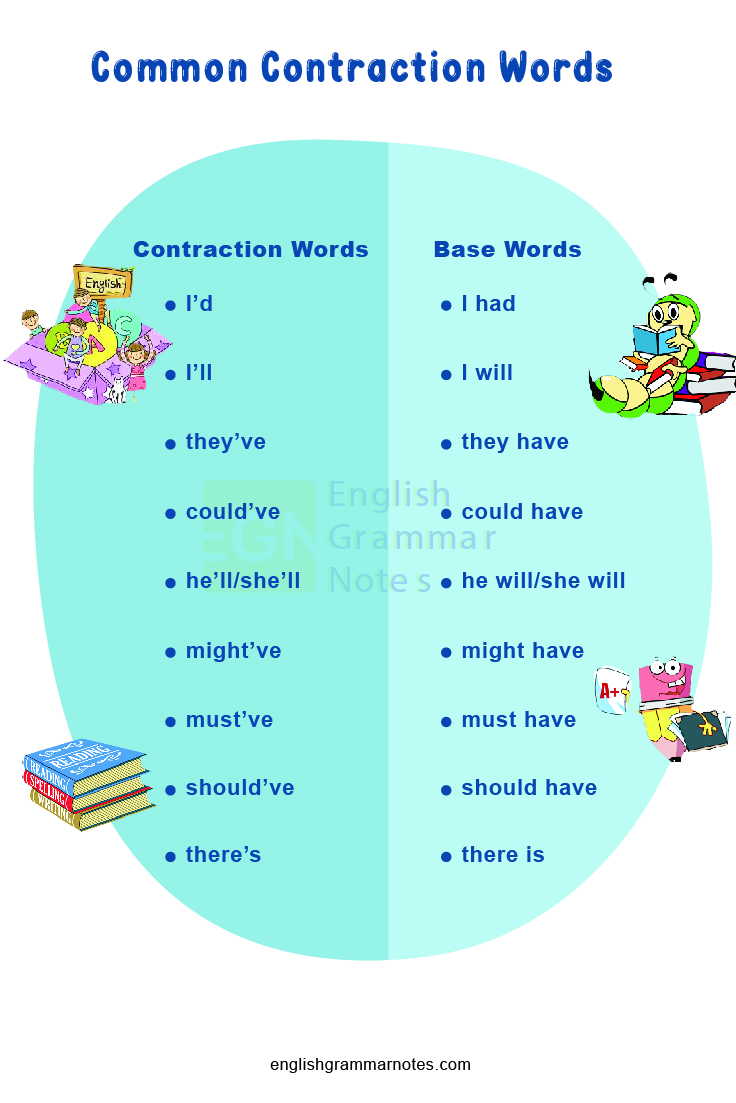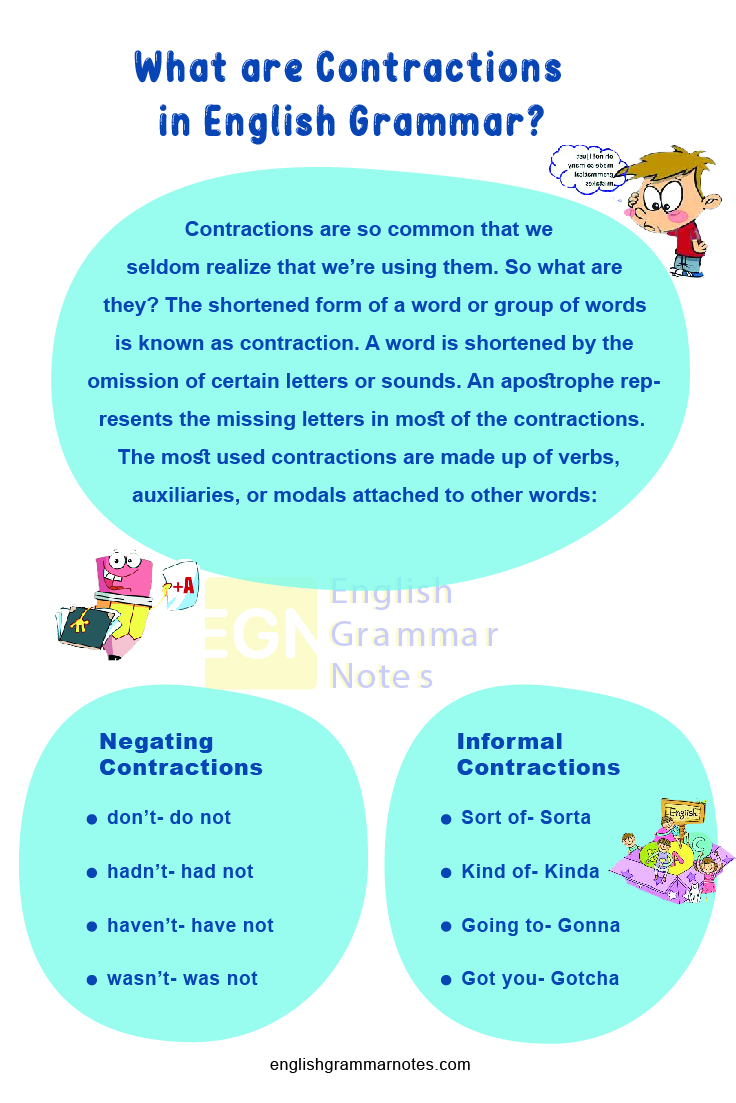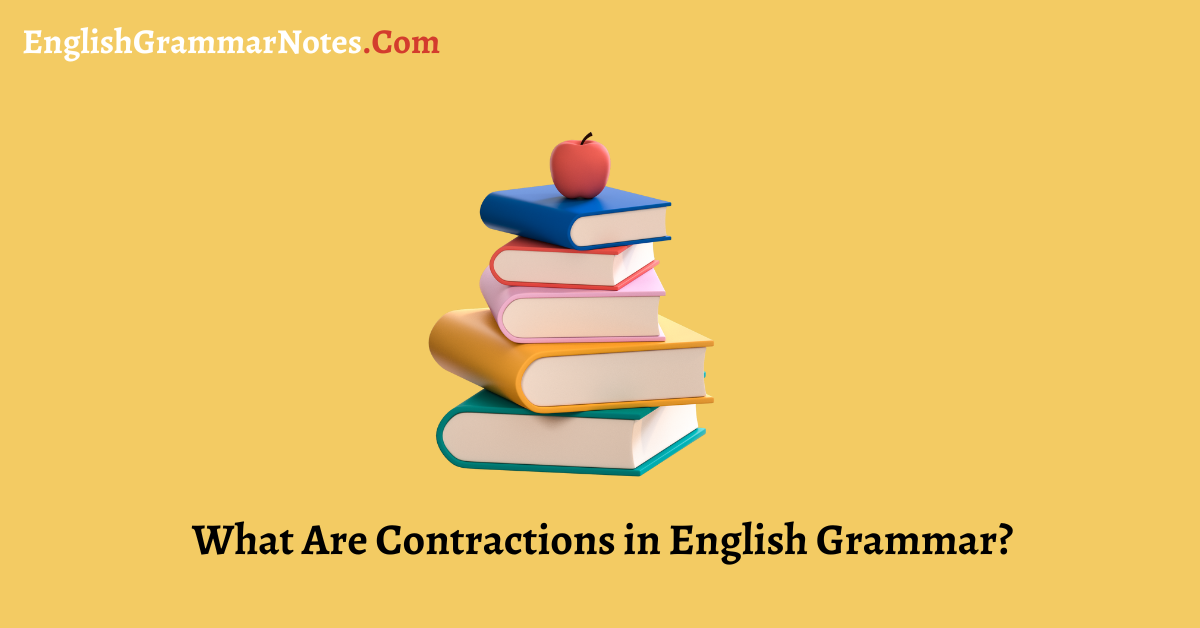Contractions are so common that we seldom realize that we’re using them. So what are they? The shortened form of a word or group of words is known as contraction. A word is shortened by the omission of certain letters or sounds. An apostrophe represents the missing letters in most of the contractions. The most used contractions are made up of verbs, auxiliaries, or modals attached to other words:
- He would=He’d.
- You cannot=You can’t
- I have=I’ve.
- They are=They’re
Contractions are used in speech and informal forms of writing. However, make sure to avoid contractions in formal writing.
- How do Contractions Work?
- When to Use Contractions?
- Common Contraction Words
- Negating Contractions
- Interrogative Contractions
- Informal Contractions
- Importance of Contractions
- What are the benefits of using contractions?
- When are contradictions used?
- What are some of the common contractions in English?
How do Contractions Work?
As already mentioned all contractions consist of an apostrophe that represents the missing letters. Identifying the right place to put the apostrophe can appear tricky, but there is a rule that works with every contraction.
Contractions are made of two words that are shortened. An apostrophe replaces any letters that were present in the original words, but that which do not exist in the contraction. Example: The contraction wouldn’t mean would not. The ‘o’ in not’ is not there in the word wouldn’t. The apostrophe takes its place, right between the n and t.
When to Use Contractions?
You can use contractions in many cases and they are explained as follows
- Contractions are common in everyday conversations. The use of contractions saves time.
- Some people are often misguided thinking that contractions should never be used in writing. This belief is wrong. The use of contractions depends on the tone of writing.
- In informal writings, you can make use of contractions to maintain a friendly tone. In formal writings, contractions are avoided to maintain a serious tone.
See More:
Common Contraction Words
Given below is a list of the most commonly used contractions:
| Contraction Words | Base Words |
| I’d | I had |
| I’ll | I will |
| I’m | I am |
| I’ve | I have |
| they’ve | they have |
| could’ve | could have |
| he’d | he had or he would |
| he’s | he is |
| he’ll/she’ll | he will/she will |
| we’d | we had or we would |
| we’ll | we will |
| we’re | we are |
| we’ve | we have |
| let’s | let us |
| might’ve | might have |
| must’ve | must have |
| she’d | she had or she would |
| should’ve | should have |
| there’s | there is |
| they’re | they are |
| they’d | they would |
| they’ll | they will |

Negating Contractions
These contractions include the word ‘not’ and negate the meaning of the verb.
- don’t- do not
- hadn’t- had not
- hasn’t- has not
- haven’t- have not
- isn’t- is not
- shouldn’t- should not
- wasn’t- was not
- weren’t- were not
- won’t- will not
- aren’t – are not
- can’t- can not
- couldn’t- could not
- didn’t- did not
- doesn’t- does not
- mustn’t- must not
Interrogative Contractions
Interrogative adverbs are generally combined with the verb to form a contraction. These include
- What are = What’re
- What will = What’ll
- Where is = Where’s
- Where are = Where’re
- Where will = Where’ll
- Who is = Who’s
- Who are = Who’re
- Who will = Who’ll
- Who had, who would = Who’d
- Who have = Who’ve
- What is = What’s
- Where had, where would = Where’d
- Where have = Where’ve
- Why is = Why’s
- What had, what would = What’d
- What have = What’ve
- When is = When’s
- When are = When’re
- When will = When’ll
- When had, when would = When’d
- When have = When’ve
Informal Contractions
Many contractions have evolved through speech. However, these informal contractions are not used in formal writing. Here is a list of such contractions:
- Sort of- Sorta
- Kind of- Kinda
- Got to- Gotta
- Going to- Gonna
- Got you- Gotcha
- Dancing- Dancin
- Give me- Gimme

Importance of Contractions
Contractions aren’t mandatory in written English. Using the complete word is always grammatically correct. However, there are several reasons why contractions are preferred in English:
- Contractions provide a friendly tone to what you write. The use of contradictions makes it appear as if you are directly “talking” to your reader.
- In a novel or play, contractions help you reflect on how a character Most importantly, contractions save space. Advertisements, slogans, and other written works can be kept short with the help of contractions.
FAQs on Contractions
1. What are the benefits of using contractions?
The shortened form of a word or group of words is known as contraction. A word is shortened by the omission of certain letters or sounds. The use of contraction gives a friendly tone to what you write. In addition, it also saves your space and time.
2. When are contradictions used?
- Contractions are common in everyday conversations.
- In informal writings, you can make use of contractions to maintain a friendly tone.
- In formal writing, contractions are avoided to maintain a serious tone.
3. What are some of the common contractions in English?
The shortened form of a word or group of words is known as contraction. A word is shortened by the omission of certain letters or sounds. Some of the common contractions include: we’d, I’d, Who’re, she’d, etc.
Conclusion
Contractions are common in English. Even though contractions may seem confusing at first, it’s the aptest way for you to save time and space. Hence the use of contractions makes your speech and writing simpler. Check out English Vocabulary Words as well to expand your knowledge base on the language.
